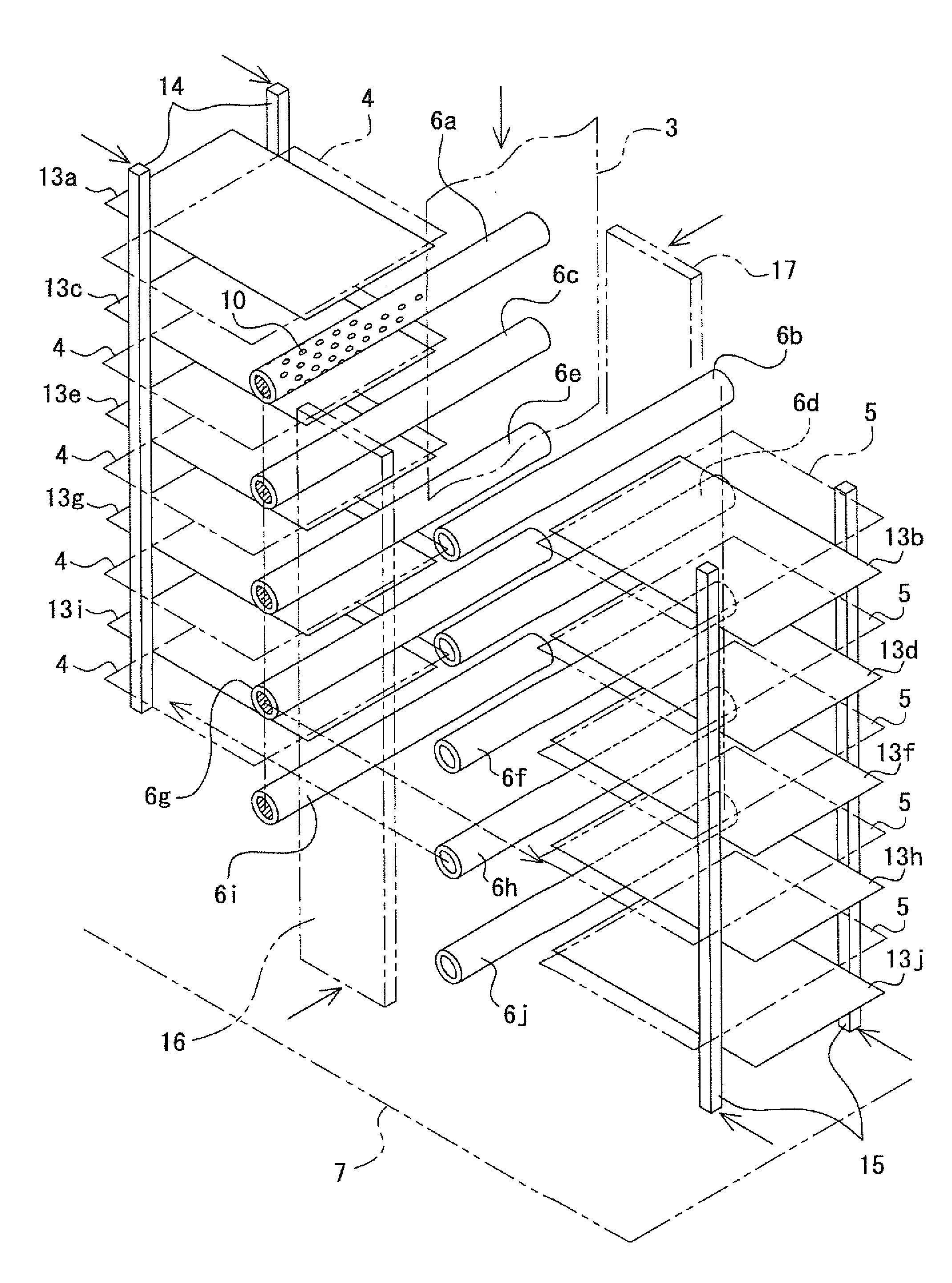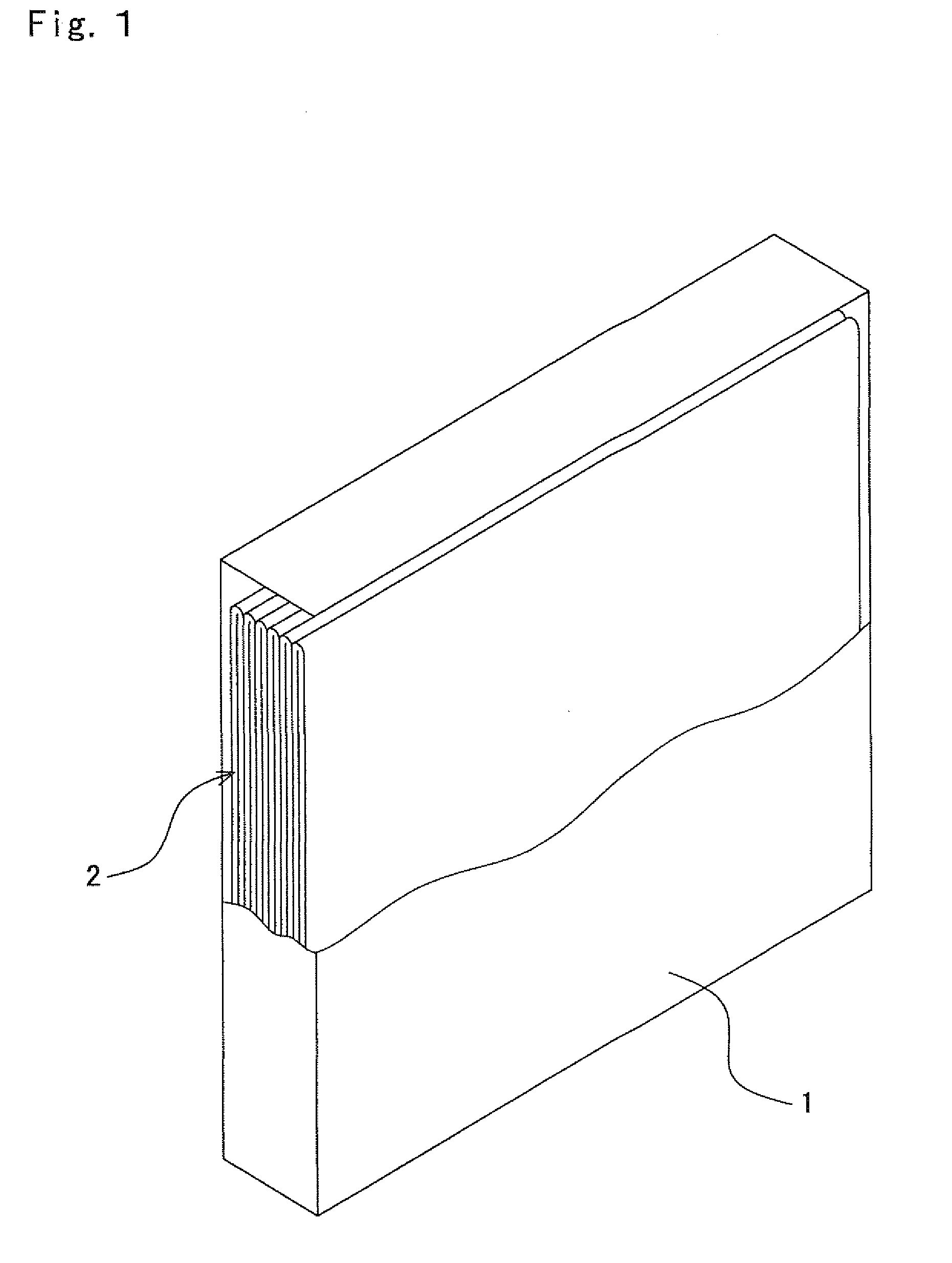Method and apparatus for manufacturing electrode assembly for rectangular battery
a manufacturing method and rectangular battery technology, applied in the direction of wound/folded electrode electrodes, sustainable manufacturing/processing, final product manufacturing, etc., can solve the problems of reducing the productivity reducing the efficiency difficulty in ensuring the positional performance of the positive and negative electrodes, etc., to achieve accurate manufacturing of the electrode assembly, short takt time, and high performance
- Summary
- Abstract
- Description
- Claims
- Application Information
AI Technical Summary
Benefits of technology
Problems solved by technology
Method used
Image
Examples
first embodiment
[0158]With reference to FIG. 1, reference numeral 1 denotes a rectangular case of a lithium ion secondary battery, reference numeral 2 denotes an electrode assembly accommodated in the rectangular case 1. Positive terminal and negative terminal, both not shown, are provided at predetermined positions of the rectangular case 1. Electrolyte formed by combining organic solvent with lithium salt fills in the rectangular case 1.
[0159]The electrode assembly 2 is formed, as shown in FIG. 2, as a laminated structure including a continuous member 3 of separator formed in zigzag form (which may be called separator continuous member 3 or merely continuous member 3, hereinlater), and positive electrodes 4 and negative electrodes 5 alternately inserted respectively into valley grooves 3a of the continuous member 3. Further, it is to be noted that the term “valley grooves 3a” used herein are portions of the continuous member 3 of the separator which are formed by folded (bent) bottom portions in ...
second embodiment
[0201]As shown in FIG. 9, an electrode assembly 22 according to this second embodiment includes a laminated member composed of a continuous member 23 folded in zigzag form and the positive electrodes 4 inserted into valley grooves 3a of the continuous laminated member 23, respectively. The continuous laminated member 23 is a laminated member composed of two rows of continuous members 3, 3 of the separators and a continuous negative electrode 24 interposed between the two rows of the separators. According to this structure, the positive electrodes 4 inserted into the respective valley grooves 23a of the continuous laminated member 23 oppose to the continuous negative electrode 24 with the separator being interposed therebetween. The positive electrodes 4 and the continuous negative electrode 24 are provided with lead portions 4a and 24a which are projected from the separator in opposing directions, and these lead portions 4a and 24a are bundled respectively, which are then connected ...
third embodiment
[0205]In the third embodiment, as shown in FIG. 12, a link mechanism 25 is utilized as the pitch changing mechanism for narrowing the interval between the rows of the guide rods 6a, 6b, 6c, 6d, 6e, 6f, 6g, 6h, 6i and 6j in the perpendicular direction.
[0206]This link mechanism is a parallel motion mechanism including a plurality of members each pivoting links 25a, 25a having the same length so as to provide an X-shape, which are connected by means of pins in perpendicular direction. A shaft 26 of the guide rods 6a, 6c, 6e, 6g and 6i is inserted into each pivot point of the X-shaped paired links 25a, 25a, and one end of each of the shafts 26 is inserted into a guide groove 27a of a guide member 27 extending in the perpendicular direction. In order to easily hold horizontally the guide rods 6a, 6c, 6e, 6g and 6i, a plurality of link mechanisms may be arranged in rows as occasion demands.
[0207]Though not shown, substantially identical arrangements of the link mechanisms and guide member...
PUM
| Property | Measurement | Unit |
|---|---|---|
| time | aaaaa | aaaaa |
| time | aaaaa | aaaaa |
| takt time | aaaaa | aaaaa |
Abstract
Description
Claims
Application Information
 Login to View More
Login to View More - R&D
- Intellectual Property
- Life Sciences
- Materials
- Tech Scout
- Unparalleled Data Quality
- Higher Quality Content
- 60% Fewer Hallucinations
Browse by: Latest US Patents, China's latest patents, Technical Efficacy Thesaurus, Application Domain, Technology Topic, Popular Technical Reports.
© 2025 PatSnap. All rights reserved.Legal|Privacy policy|Modern Slavery Act Transparency Statement|Sitemap|About US| Contact US: help@patsnap.com



